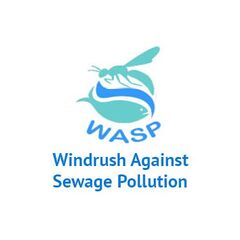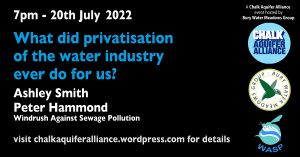Windrush Against Sewage Pollution
(Registered charity) | |
|---|---|
 | |
| Founder | Ashley Smith |
| WASP – dedicated to bringing the River Windrush back to good health | |
Windrush Against Sewage Pollution (WASP) are a group of volunteers, investigating the pollution of the River Windrush and her sister rivers. WASP have discovered that untreated sewage is being dumped into the water – sometimes in huge quantities and for long periods of time. This is happening to rivers across the country.
Motto: "Rivers are for wildlife and people. Not sewage pollution."[1]
Contents
River Windrush
The River Windrush is a tributary of the River Thames in central England. It rises near Winchcombe in Gloucestershire and flows south east for 65 km (40 miles) via Burford and Witney to meet the Thames at Newbridge in Oxfordshire.
The river gives its name to the village of Windrush in Gloucestershire.[2]
Water privatisation

On 20 July 2022, WASP's Peter Hammond and Ashley Smith examined the economic and regulatory implications of water industry privatisation. Spoiler alert: it wasn't pretty.
Registration here.
Evidence given to Parliament
In February 2021, Professor Peter Hammond submitted written evidence to Parliament answering two questions:
- How adequate are the monitoring and reporting requirements around water company discharges?
- How can technology improve and assist with transparency and enforcement?
Summary
1.1 I am a mathematician with 40+ years’ experience as a university academic, the last 20 at UCL’s Institute of Child Health and Oxford’s Big Data Institute, applying image analysis of neurofacial anatomy in medical genetics and teratology. I am retired with recent/current visiting research posts at the UK Centre for Ecology & Hydrology (2018-20) and Dept. of Human Genetics, Leuven University, Belgium (2017-21). I also work in conjunction with Windrush Against Sewage Pollution (WASP). A paper on untreated sewage spills and artificial intelligence is forthcoming:
1.2 Hammond P, Suttie M, Lewis V, Smith A, Singer A. Detection of untreated sewage discharges to watercourses using machine learning, Clean Water (2021), in press.
1.3 I have lived in a converted mill on the River Windrush for 18 years with direct experience of its decline in terms of increases in turbidity, algal growth and riverbed silt; decrease in river weed growth; population decline of invertebrates, fish, watervoles and waterfowl in the river; and, complete loss from my riverside garden of common lizards, grass snakes and otters. The two contrasting views of the River Windrush at the same location (Annexe 1), taken from my garden, illustrate the river’s decline between 2009 and 2017. Sewage pollution may not be the sole culprit for this ailing ecosystem but aquatic and environmental scientists suggest it is affecting flora and fauna at the bottom and middle of the food chain with inevitable consequences.
1.4 The decline of the River Windrush and rivers nationally, and a growing awareness of spills of sewage into watercourses, stimulated my interest in how spills arise, are self-reported by the Water Companies (WCs), are detected by event duration monitors (EDMs) and how permits to discharge sewage to watercourses are enforced by the Environment Agency (EA). My evidence is selected from an analysis of data gathered over 3 years via Environment Information Requests (EIRs) for 2009-2021 covering 100 sewage treatment works (STWs) in detail, 300 or so superficially, and interactions with OFWAT, EA, WCs, other scientists and members of the public affected by sewage spills.
1.5 The evidence I have selected suggests that
- there are many more spills than reported by the general public and WCs
- spills are not infrequent and due to short-lived “storm” events as claimed by WCs
- EDM devices are not yet fully reliable in the detection of spills
- the EA needs expertise in Big Data analysis to cope with the volume of accumulating sewage treatment and monitoring data to assist their enforcement of permit conditions
- terms in EA permits are being abused and need precise definition (e.g. “rainfall” needs a technical definition; “effluent” must not mean a mix of untreated sewage and treated effluent)
- citizen science contributes to spill detection and permit enforcement and deserves more funding
- WCs should publish effluent quality, metered flow and spill start/stop times, a month in arrears
- volumes of untreated sewage spills are essential to understand their impact on river ecosystems and to inform punitive fines to discourage poor STW maintenance and management[3]